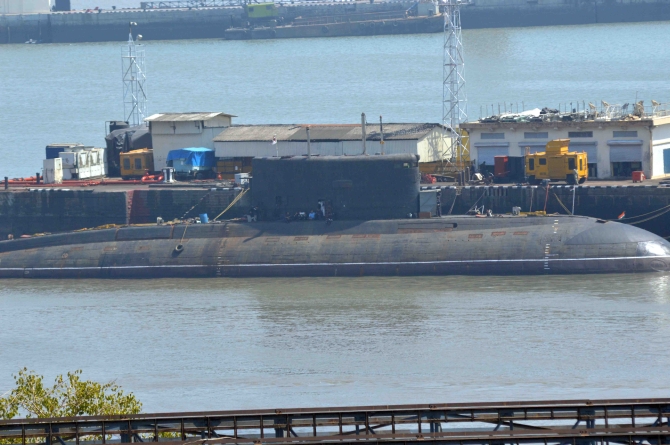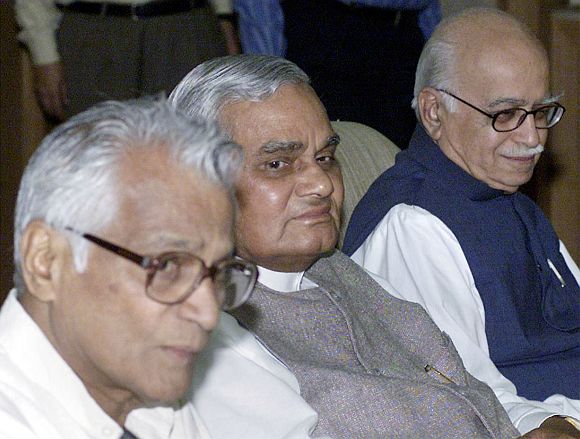
Forget the big-ticket stuff, for years we have not even been able to dredge Mumbai harbour so that submarines can move in and out round the clock, rues T N Ninan
It is remarkable how quickly the defence narrative has changed, from that of a country busy re-equipping its armed forces -- and getting the moniker of being the world’s largest arms importer -- to one whose navy operates with death-trap submarines, whose air force has only two-thirds of the squadrons required, whose army functions without such basics as night-vision capabilities, and whose missile armoury does not match the challenges mounted by neighbours.
Many weapons acquisitions programmes talked about for years are still to be ordered, let alone delivered; the list includes the Rafale combat aircraft, heavy-lift (Chinook) and attack (Apache) helicopters, light howitzers that can be airlifted to the Chinese border, a fresh lot of new frigates, and a new batch of submarines (on top of those being manufactured at Mazagon Docks) whose ordering process has come to a halt because of budget constraints.
The experts will add more to this list (minesweepers, air defence equipment, etc), but the message should be clear: the country’s defence capabilities have fallen way behind requirements as well as strategic goals.
Click on NEXT for more...

The excitement over a new aircraft-carrier (which, like all the new submarines, destroyers and frigates on order will only serve as replacement) and nuclear submarines has masked the sorry part of the story.
Forget the big-ticket stuff, for years we have not even been able to dredge Mumbai harbour so that submarines can move in and out round the clock; consequently, such movement is restricted to the high-tide periods -- and is one reason why a sub scraped its bottom recently.
Two factors have been at work, and the first (inevitably) has to do with money. For all the talk of buying hardware, the fact is that no government in recent memory has given enough money for defence.
Consider the 16-year record of Manmohan Singh and his predecessor, Atal Bihari Vajpayee. Total defence spending, as a percentage of GDP, went from 2.45 per cent in the last year of the Rao government (1995-96) to 2.55 per cent in the first year of the Vajpayee government (1998-99), but has been on the slide since -- to 2.38 per cent in Mr Vajpayee’s last year (2003-04), further to 2.15 per cent in the last year of the first Singh government, and now just 1.8 per cent in Dr Singh’s terminal year.
Click on NEXT for more...

The small mercy is that, out of this shrinking pie, the share of the capital (ie hardware) budget has steadily increased. But as a share of GDP, in all these 16 years, the budget for weapons has been generous in only the first year of the Singh government (when it was 1.07 per cent of GDP).
This year, it is no more than 0.70 per cent, marginally better than what it was in the last year of the Vajpayee government (0.66 per cent).
The second part of the story is the inability to buy hardware because of repeated scandals in defence buying. This has derailed or slowed down so many purchases that the only way to proceed seems to be to give up competitive bidding and do bilateral deals, with the Russians, Americans (where the Pentagon decides the price) and perhaps Israelis.
The flawed acquisition process and long delays in domestic production have meant that even meagre weapons budgets have often gone unspent; the shortfalls have ranged from 10 per cent to 30 per cent, with George Fernandes being the biggest culprit even as he posed as the jawans’ hero.
The net result is that the country’s defence has been put at avoidable risk, and our defence forces asked to make do with less than the minimum they require to do their job.
Neither desperate pleas by successive service chiefs nor embarrassing face-offs with the Chinese have led to this picture changing. So what will it take, another defeat in war?
Click on NEXT for more...
Click on MORE to see another PHOTO feature...